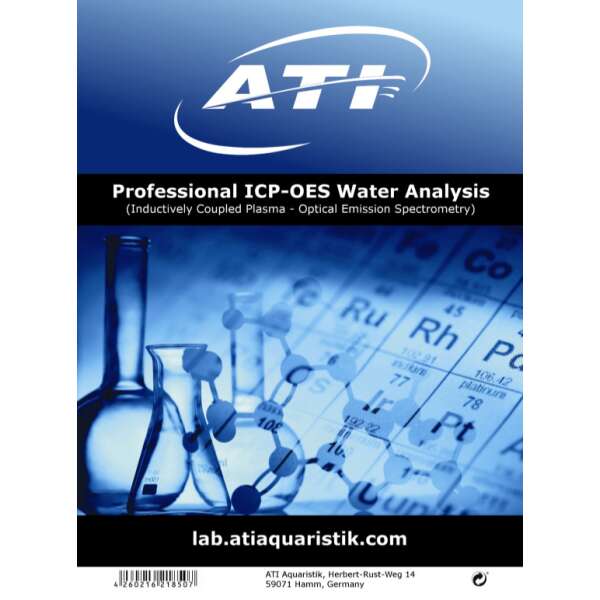ATI ICP-OES Analysis

Top notch water analysis
- high precision - measuring concentrations down to less than 1 µg/l
- for especially high requirements in element analysis
- determine the individual consumption of your aquarium system
- identify sources of pollution that could be the cause of many problems
- for the targeted optimization of your aquarium system
- Manufacturer:ATI Aquaristik GmbH
Any successful saltwater aquarium is based on correctly adjusted, near-natural water values. A deviating water composition is the most common cause of a variety of problems in the aquarium, such as algae growth or coral death. At the same time, the correct measurement of water values is a major challenge.
Using the high-precision ATI laboratory analyses offers you the advantage that the most important water values (e.g. calcium, magnesium, salt content etc.) can be determined much more accurately and reliably than is possible with commercially available droplet tests. In addition, you receive a comprehensive overview of a large number of other relevant elements that can only be determined with professional laboratory analysis.
For this purpose, the ATI laboratory has a large number of highly specialized analysis devices such as ICP-OES, ICP-MS, ion chromatographs and titrators. The most suitable measuring method is used depending on the element.
Led by Dr. Ben Funk, the ATI laboratory has many years of experience in analytics. We guarantee reliable and reproducible analysis results and are always available to answer any questions you may have about the measurement results.
With ATI, you can choose between three types of water analysis with different measurement scopes: Standard, Pro and Ultimate.
ATI Laboratory Analysis Ultimate combines ICP-OES and ICP-MS to give you the highest accuracy in all areas and our most comprehensive analysis. With the ATI Laboratory Analysis Ultimate you benefit from numerous Advantages:
- Higher accuracy and significantly lower detection limits down to the ultra-trace range through ICP-MS (e.g. manganese, selenium, vanadium, arsenic etc.) - Detection element-specific down to 0.001 µg/l possible (cf. detection limit ICP-OES 0.5 - 3.5 µg/l depending on element)
- Earlier detection of pollutants: Enables faster reactions to avoid problems
- Expanded element portfolio (so-called MS trace elements* and MS contaminants*): Rubidium, neodymium, zirconium, etc.
- Double validated results: Many values are measured with both ICP-OES and ICP-MS and checked for plausibility. Measurement errors can therefore be ruled out even more reliably
- Expanded element portfolio (so-called MS trace elements* and MS impurities*): rubidium, neodymium, zirconium and many more
- The most suitable measurement method is used for each water value - e.g. bulk elements with ICP-OES, trace and ultra-trace elements with ICP-MS.
Depending on the version of the test, the analysis values include the following:
- Salinity (salt content in PSU)
- KH (=carbonate hardness / alkalinity)
- Nutrients: nitrogen / nitrate, phosphorus / phosphate
- Quantity elements: Sodium, calcium, chloride, magnesium, sulphur, potassium, bromine, strontium, boron, fluorine
- OES trace elements: Barium, beryllium, iron, iodine, lithium, molybdenum, silver, silicon
- OES pollutants: aluminum, antimony, bismuth, cadmium, lanthanum, thallium, titanium, tungsten
- MS trace elements*: Arsenic, chromium, cobalt, copper, manganese, nickel, rubidium, selenium, vanadium, zinc, tin
- MS pollutants*: Lead, neodymium, niobium, zirconium, indium, germanium, gallium, mercury, tellurium









